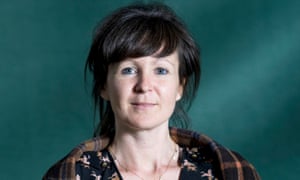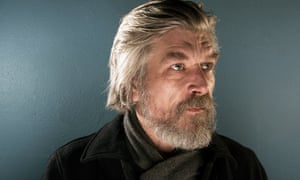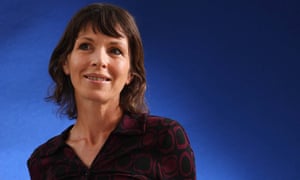 |
| Illustration by Francesco Ciccolella |
Drawn from life: why have novelists stopped making things up?
Karl Ove Knausgaard, Rachel Cusk, Sheila Heti, Edward St Aubyn – authors are using their own life stories in their fiction. Does the boom in autofiction spell the end of the novel, asks Alex Clark
Sat 23 Jun 2018
“T
hat was the morning that white people finally realised the president of the United States was a white supremacist, he’d as good as said so, there was a cartoon in the Guardian of the White House with a Klan hood over the roof. Why were people surprised, weren’t they listening to anything? ... People weren’t sane anymore, which didn’t mean they were wrong. Some sort of cord between action and consequence had been severed. Things still happened, but not in any sensible order, it was hard to talk about truth because some bits were hidden, the result or maybe the cause, and anyway the space between them was full of misleading data, nonsense and lies.”
So says Kathy, the protagonist of Olivia Laing’s novel Crudo. Yes, a novel – not, as that passage might indicate, an essay or a piece of political journalism. Who is Kathy? She is part Laing, the author of non-fiction titles The Lonely City and The Trip to Echo Spring, in the summer of 2017, as she observed the world around her and prepared to get married. But she is also the late American novelist Kathy Acker, whom Laing audaciously fuses with her present-day character. Crudo slips sinuously between “Kathy” the pre-millennial icon of the American counterculture and a 21st-century woman on the brink of multiple life changes. The action slides from a luxurious holiday in Italy to Korea, Grenfell, Steve Bannon’s resignation, a priest giving a sermon in Italian “in which the word WhatsApp was frequently discernible”.
Suddenly this kind of “autofiction” – fictionalised autobiography that does away with traditional elements of the novel such as plot and character development – is everywhere. Thumping on to your desk in the form of the last volume of Karl Ove Knausgaard’s epic account of his life, My Struggle; touching more lightly down in the case of Kudos, as Rachel Cusk completes her elegant trilogy in which a novelist, “Faye”, journeys around Europe absorbing the stories strangers and acquaintances tell her; in Motherhood, in which Canadian writer Sheila Heti dramatises her own interrogation of what it might mean to choose – or choose not – to have children. Édouard Louis’s History of Violence, Delphine de Vigan’s Based on a True Story, Joanna Walsh’s Break.up, Chris Kraus’s I Love Dick, Edward St Aubyn’s Patrick Melrose series – these books don’t simply use the biographical details of their authors’ lives as inspiration, but also to disrupt and complicate our experience of story and subjectivity, to find a new way to describe reality at a time when, as Kathy says in Crudo, it is “hard to talk about truth” and perhaps even harder to write it.
In the perpetual present of social media, when personal presentation, on Facebook, Instagram, Twitter, is everything, these autofictions offer an alternative, experimental narrative of self. They are attempts to reshape and repurpose a literary form, and their sudden popularity speaks to the idea that to capture 21st-century experience writers must breach borders – blend fiction, memoir, history, poetry, the visual and performing arts. One passage in Crudo juxtaposes buying paint from Homebase with a Nazi march in Charlottesville, the machine gunning of refugee ships in the Mediterranean and Hiroshima; a mixture of the everyday, the concurrent violence of elsewhere and traumatic Big History.
“L’autofiction, c’est comme le rêve; un rêve n’est pas la vie, un livre n’est pas la vie.” Serge Doubrovsky, the French writer and theorist whose 1977 novel Filsis widely credited as the first work of “autofiction”, provides not a definition but an elaboration: autofiction is as a dream; a dream is not life, a book is not life. But what manner of dream might it be?
Edmund White – author of both autobiography and of novels that call on real-life incidents – draws a line between the two forms. “To me there’s a very clear distinction between autofiction and autobiography,” he told the magazine Asymptote. “I’ve just finished my third autobiography, the first two being My Lives and City Boy. I try, in those books, to be true and accurate. I believe in truth, I don’t buy this bullshit that everything is fiction, I think that’s silly. Most people know that the truth is something like a horizon; it’s something you head toward. Maybe you never get there, but at least you have a sense of direction.”
By contrast, for White the liberties that writers of fiction can take with truth – compressing events, creating composite characters – are a way of freeing them from the charge of lying by, paradoxically, making things up. It’s not an unusual stance for such a writer to take, and nor does it contradict analyses that approach the question from a slightly different angle, such as that of the short story writer Lucia Berlin, who told the New Yorker: “Somehow there must occur the most imperceptible alteration of reality. A transformation, not a distortion of the truth. The story itself becomes the truth, not just for the writer but for the reader. In any good piece of writing it is not an identification with a situation, but this recognition of truth that is thrilling.”
That idea of transformation might jar with those familiar with the toe-breaking weight of My Struggle, in which, it appears, no detail is too minute to exclude (“I went into the kitchen, took the plastic container with the meat sauce out of the fridge, then the spaghetti, divided it between two plates and started heating the first one in the microwave …”). And yet, its mundanity is its manifesto. You think this is dull? Knausgaard seems to ask. What about me? I have to live it and write it.
Where does this leave invention? The question of its meaning and value seems to grip the current tranche of autofictioneers, keen to probe the hierarchies and hypocrisies that impose themselves on writing. Long have aspiring fiction writers been told to write what they know, only to find themselves criticised for lacking imagination. In other words, give voice to your subjectivity but avoid narcissism; make it up, or we’ll think you can’t. Tell the truth, or we’ll think you’re a liar.
Many forms of writing are a push-me, pull-you of cloaking and revelation. In a public discourse that privileges the performative – in politics, in our social lives, even in our friendships – the idea of what one conceals and what one shows becomes ever more urgent and telling. But the effects of that idea do not always fall equally. Female writers and writers of colour, for example, are bedevilled by the expectation – from readers and critics – that their work is based in the reality of their own lives; what follows is a treasure hunt for the “real” in their imagined worlds, and a diminution of its importance.
Stories of intimate life and family relationships become “domestic”. Aminatta Forna writes a novel set in Croatia but finds it shelved in the “African section” of a bookshop. Man Booker prize-winner Marlon James has spoken about the constraints this places on the freedom to imagine, which is partly why his next project, Dark Star, is a fantasy epic that he has described as “an African Game of Thrones”.
The writer Chris Kraus, whose novel I Love Dick explored infidelity, desire and jealousy through such a layering of techniques and perspectives that it was almost impossible for the reader not to feel giddily promiscuous, rejects the term autofiction: “I would never use that term. It’s such a strange term. It’s applied to my work, and to a lot of other people’s work, but I would never use it. There are so many examples in the history of literature of a male first-person that’s used pretty closely to the identity of the writer, and we don’t call it that. The corny beat example, Jack Kerouac, we don’t call that autofiction. Herman Melville, do we call that autofiction? All of American realism that’s written in the first person – we don’t call that autofiction.”
 |
| Karl Ove Knausgaard |
Recall how quickly Knausgaard’s series and Elena Ferrante’s Neapolitan novels were hijacked into a reductive attempt to assess the differences between male versus female “telling”. Knausgaard: accretion of detail so exhaustive as to mesmerise, or stupefy, the reader in the service of recapturing the vast psychic shifts of childhood becoming manhood. Ferrante: the mystery of female friendship conveyed by appropriation of the soap opera or family saga.
But in fact Ferrante’s work derives its strength not from a belief in the dynamic power of story and character but from a deep ambivalence towards them. Its key descriptive target, Lila, eludes the figure of the writer, Lenu; having literally disappeared at the beginning of the quartet, Lila is defined as much by absence as presence, haunted by a sense of a dissolution of the boundaries between herself and the world, constantly re-presenting as vamp, moll, businesswoman, mother, controller and controlled. In one strand of the story she is an anti-Cinderella, creating a shoe that will liberate her but that is then stolen by the men around her.
Ferrante’s work is a fairytale that reveals the social order, much as Angela Carter’s does, and what happened outside the text – her refusal to share her own identity – became part of that fairytale. A woman who will not submit to being known in even the most basic of biographical details is a woman who understands that it will never stop at that; that absence is the only route to self-preservation but one that might, even then, fail in the face of an outraged desperation to uncover the real.
But how does the real cope with writing – the translation of observable fact, transient sensation, other minds, into words? In her memoir/essay/manifesto The Cost of Living, Deborah Levy recalls a scrawl over a typewritten diary entry from decades previously, “featuring the word it”.
It begins with knowing and not knowing, a glass of milk, rain, a reproach, a door slammed shut, a mother’s sharp tongue, a snail, a wish, bitten fingernails, an open window. Sometimes it is easy and sometimes it is unbearable.
What, Levy wonders now, is “it”? The presence of the glass of milk leads her to her most recent novel, Hot Milk, of which this might have been some faint precognition; a single word, a feeling of indeterminacy and strikingly symbolic objects – door, snail, window – that eventually cohere into a narrative. “The appeal of writing, as I understood it,” she notes, “was an invitation to climb in-between the apparent reality of things, to see not only the tree but the insects that live in its infrastructure, to discover that everything is connected in the ecology of language and living.”
Later, she writes humorously of being usurped as an object of interest when men in the street stop her to ask about the workings of her e-bike; dutifully, she provides an explanation of its speed and motor, ruefully realising she has become a minor character in her life.
To write autofiction, however, requires a willingness to treat oneself as the central character, a countercultural celebrity, and this is probably what has sparked resistance to it. It requires ego, it demands the bold determination to make a mark. In the case of Cusk, that started some time ago, when she wrote about motherhood and divorce in A Life’s Work and Aftermath and faced a censure that declared itself on behalf of the unknown others – the children, the husband – in her story. It seemed a convenient moment for such scruples to arise in a culture otherwise fairly used to the blithe incorporation of others’ lives, and it brought to mind Virginia Woolf’s imagined objections of those who would thwart female creativity in Three Guineas:
But to sell a brain is worse than to sell a body, for when the body seller has sold her momentary pleasure she takes good care that the matter shall end there. But when a brain seller has sold her brain, its anaemic, vicious and diseased progeny are let loose upon the world to infect and corrupt and sow the seeds of disease in others. Thus we are asking you, Madam, to pledge yourself not to commit adultery of the brain because it is a much more serious offence than the other.
Somehow, one felt, Cusk stood accused of selling her life and her brain, and her subsequent trilogy, in which the writer effaces herself and thrusts forward others’ words, can stand as a response to that accusation.
As Kraus argues, when it comes to the reading of literature, who speaks and what they decide to say is critical, and often contested. Speech in Cusk’s trilogy is a charged affair, presented in a variety of ways: the narrator’s indirectly, her interlocutors most usually within speech marks. At the beginning of Kudosshe creates a conversation between Faye and her overseas publisher, who is explaining how his company has returned to profitability via a combination of sudoku and deprioritising “literary” novels. Musing on the tendency of online commenters to award the likes of Dante a one-star review, he argues that Dante can look after himself. “It was a position of weakness, he believed, to see literature as something fragile that needed defending.”
Faye counters that his attitude seems cynical, and that one should stick up for Dante “at every opportunity”, regardless of whether he needed it or not. The publisher’s response will be recognisable to all those who have attempted to interrogate the ready-made opinion of an authority figure:
While I was speaking my publisher had been stealthily removing his eyes from my face in order to look at something over my shoulder, and I turned to see a woman standing at the entrance to the bar gazing around herself nonplussed with her hand shading her eyes, like a voyager peering into foreign distances. ‘Ah!’ he said. ‘There’s Linda.’
Writers, then, need strategies to meet the darting eyes of those too powerful, or otherwise occupied, to listen to them. In the current flowering of autofiction, it is noticeable how many women are coming to the fore, but also how some of those women – largely white, highly educated, often influential in other creative spheres – already occupy zones of privilege.
Writers of colour, working class and queer voices have also needed to find ways to break free of the strictures of the realist novel. Claudia Rankine makes a distinction between the “self self” and a historical self, and is determined to subvert the American lyric tradition in order to describe what happens in the gap between the two. Adelle Stripe’s fictional re-creation of the life of playwright Andrea Dunbar, Black Teeth and a Brilliant Smile, and memoirist Michelle Tea’s novel Black Wave are other examples. Both books are unimaginable without the freedom to disrupt the form – what Louis has spoken of as a way to confront the bourgeois attempt to contain violence and threat within a safely defined frame.
But we should be wary of creating false oppositions between different kinds of novel, or of assuming that realism cannot pose a threat to the social, political or aesthetic status quo. The critic Jonathan Gibb recently wrote of his reservations about the reception of autofiction as a new form that knocks previous forms aside, and sends us to “a place where to write a good old-fashioned novel, with rounded characters, and realist description, and manufactured plots, is, oh dear me yes, something that is beyond the bounds of tastefulness. As if to write a traditional novel is akin to producing ‘likable’ characters”.
Perhaps the writers of autofiction, he wonders, simply want to move on from that somewhat refined style, and “to push the novel towards the speculative, the philosophic, the contingent: the novel as scattered notes, Wittgenstein with characters”. Gibb argues that he likes both, and doesn’t want to choose between them. And, indeed, we do not have to. Just as long as we can persuade publishers to find room among the sudoku books.
Cusk’s Kudos is also the name of an imagined college award presented to outstanding students, and her novel writhes with characters trying to define and measure what success might be – a particularly unfathomable problem when it comes to art. One of its most wry moments comes when Faye encounters Ryan, whom readers will recognise as a hotshot young Irish writer from Outline. At first, witnessing his gaunt figure and his walking stick, she imagines that he has fallen ill, despite once believing that people like him “lived their lives with impunity”. Not a bit of it. Ryan has shed weight, gained a co-writer and a transatlantic accent, and relaunched himself as a bestselling commercial writer (the walking stick is simply because he tripped getting out of a taxi).
During their conversation he describes editing a starry charity anthology that led to a “mind-blowing” auction for serial rights. “‘Unfortunately,’ he said, ‘the economics of it meant we couldn’t ask people like yourself for contributions, since the whole point of it was to make money and as I say, we needed the big names for that.’” Kudos indeed.





No comments:
Post a Comment